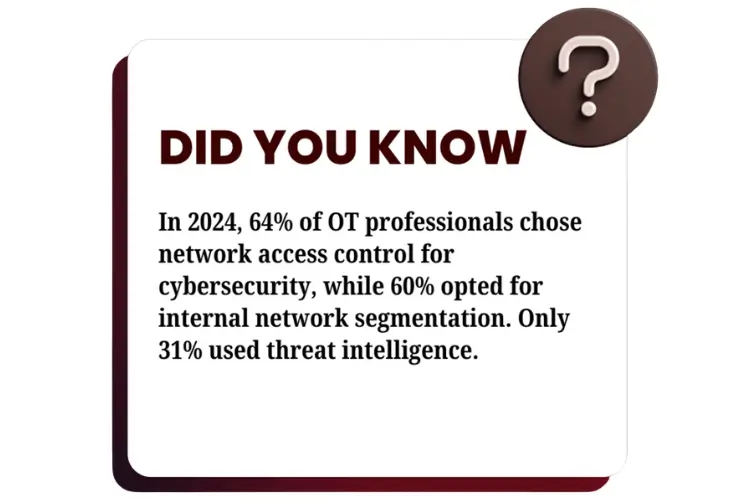In today’s interconnected world, the gap between information technology and operational technology continues to shrink. Yet many organizations still treat OT security as an afterthought.
Recent statistics reveal that organizations reported an increase in OT-related cyber incidents last year (Ponemon Institute, 2023), making the need for comprehensive protection even more urgent.
Whether you manage power grids, manufacturing floors, or water treatment facilities, developing a robust OT security strategy isn’t just recommended—it’s essential for survival.
The Critical Intersection of OT and Cybersecurity
Before diving into specific strategies, let’s understand why traditional approaches often fail when applied to operational environments.
The Evolving Threat Landscape for Operational Technology
The days when industrial cybersecurity solutions existed in isolation are long gone. Modern OT environments face sophisticated threats from nation-state actors, criminal organizations, and even insiders with malicious intent. These attackers specifically target critical infrastructure, understanding that disruptions can cause cascading failures across entire regions.
Why Traditional Security Approaches Fall Short in OT Environments
Traditional IT security focuses primarily on data protection. OT security, however, must prioritize system availability and safety above all else. When an IT system fails, you might lose access to emails. When an OT system fails, you could face dangerous physical consequences.
A comprehensive cybersecurity guide tailored to industrial environments helps bridge this gap by outlining OT-specific security controls and processes.
The True Cost of OT Security Breaches: Beyond Downtime
The impacts of OT security breaches extend far beyond simple operational disruptions. They can include:
- Physical damage to equipment and infrastructure
- Environmental contamination
- Human safety risks
- Regulatory penalties and legal liability
- Reputational damage affecting customer trust
For defender operators tasked with protecting these critical systems, understanding these wide-ranging consequences is crucial for effective risk management.
As we transition to building your security knowledge base, remember that strong OT security begins with a clear understanding of what makes these environments unique.
Fundamentals of OT Security: Building Your Knowledge Base
Creating an effective security strategy starts with understanding the fundamental differences between OT and IT environments and how they interact.
Operational Technology vs Information Technology: Essential Differences
While IT systems primarily manage data, OT systems control physical processes and equipment. This creates distinct security priorities:
| IT Security | OT Security |
| Confidentiality first | Safety and availability first |
| Regular updates/patching | Limited maintenance windows |
| Centralized management | Distributed control systems |
| 3-5 year lifecycle | 15-30 year lifecycle |
| Standardized protocols | Proprietary protocols |
Understanding these differences helps security professionals develop appropriate strategies that respect operational constraints while still providing adequate protection.
The Modern OT Architecture: Beyond the Purdue Model
While the traditional Purdue Model has guided industrial network segregation for decades, modern OT environments rarely fit neatly into these defined layers. Today’s networks often feature:
- Cloud-connected field devices
- Remote access requirements
- IT-OT convergence zones
- Industrial Internet of Things (IIoT) deployments
A modern cybersecurity guide should acknowledge these realities while still emphasizing the importance of network segmentation and access controls.
Critical OT Assets That Demand Protection
Effective ICS asset management begins with identifying your most critical systems. These typically include:
- Programmable Logic Controllers (PLCs)
- Human-Machine Interfaces (HMIs)
- Distributed Control Systems (DCS)
- Remote Terminal Units (RTUs)
- Safety Instrumented Systems (SIS)
Each asset type requires specific protection measures based on its function, connectivity, and potential impact if compromised.
Emerging Convergence: Where IT and OT Security Meet
The boundaries between IT and OT continue to blur as organizations seek greater operational insights and efficiencies. This convergence creates both opportunities and risks that must be carefully managed through collaborative security approaches.
As we explore specific industrial cybersecurity solutions next, keep in mind that effective protection requires both technical controls and organizational alignment. Achieving this often involves hiring specialized or experienced IT and cybersecurity professionals. These experts have the knowledge and tools to monitor networks, implement secure access controls, and maintain reliable backup systems, ensuring that the systems operate safely and efficiently. Partnering with skilled Austin IT Services (or other locations) enables organizations to proactively manage risks while maintaining operational continuity.
Industrial Cybersecurity Solutions for Comprehensive Protection
To secure operational technology (OT) environments, organizations must adopt advanced tools and strategies tailored to industrial systems. Next-generation asset discovery tools use passive monitoring to map connected devices, configurations, communication patterns, and vulnerabilities without disrupting operations.
Automated vulnerability management replaces risky scans with passive identification, OT-specific risk scoring, and safe patch verification methods. Continuous monitoring solutions enhance real-time threat detection by flagging protocol violations, abnormal behavior, and known attack patterns.
Legacy systems, which are common in OT, can be protected with custom controls such as network segmentation, application whitelisting, and data diodes. Together, these technologies provide deep visibility and reduce operational risk, enabling defenders to prioritize threats and safeguard critical assets. A strong asset management strategy is essential to maintain long-term protection.
Implementing Effective ICS Asset Management Strategies
Robust asset management is the backbone of any effective OT security program. It starts with a comprehensive OT asset inventory that includes network-connected devices, stand-alone systems, software and firmware versions, communication protocols, and physical locations, critical for accurate risk assessments and informed security planning.
Change management is equally essential, requiring documented approvals, pre-implementation testing, rollback procedures, and post-change verification to maintain security and operational stability. Given the long lifespan of industrial systems, lifecycle management is key, involving long-term support plans, hardware obsolescence strategies, adaptive security controls, and thorough documentation of legacy dependencies.
To enhance visibility and control, advanced cybersecurity tools offer passive network monitoring, protocol integration, configuration backups, and anomaly detection. With strong asset management in place, organizations can confidently advance to comprehensive risk management.
Beyond tooling, organizations should align their asset inventories and monitoring outputs with applicable regulatory and contractual frameworks to ensure operational decisions are auditable and defensible. For companies that work with the Department of Defense or handle Controlled Unclassified Information, preparing for CMMC 2.0 readiness helps shape scoping, access controls, and evidence collection in ways that map directly to assessment requirements.
Engaging advisors who understand both OT constraints and DoD compliance expectations can turn discovery data into prioritized, achievable remediation plans. This alignment reduces surprises during assessments and makes long-term risk management far more effective.
Cyber Risk Management in OT Environments
Effective cyber risk management in OT environments demands a tailored approach that reflects the unique characteristics and operational demands of industrial systems. OT-specific risk assessments prioritize factors like safety, process continuity, cascading failure risks, and physical consequences, enabling organizations to build more accurate risk profiles.
A defense-in-depth strategy is crucial, layering physical security, network segmentation, endpoint protection, access control, and backup capabilities to ensure no single point of failure can jeopardize critical operations. Since not all assets pose the same level of risk, efforts should focus on high-value systems—identifying crown jewels, enhancing monitoring, tightening access, and preparing asset-specific response plans.
Finally, quantifying and communicating risks effectively—using business-relevant metrics and clear mitigation options—ensures leadership buy-in and proper resource allocation for OT cybersecurity initiatives.
Specialized Security Approaches for Defender Operators
Defender operators face unique challenges in protecting industrial environments. Here’s how to build effective security operations specific to OT.
Establishing OT-Specific Security Operations Centers
Traditional SOCs often lack the specialized knowledge needed for OT monitoring. Dedicated OT security operations centers feature:
- Staff with industrial control system expertise
- OT-specific monitoring tools
- Customized alert triage processes
- Integration with operational teams
These specialized centers provide more effective protection for industrial environments.
Designing Effective Incident Response for Industrial Environments
OT incident response must prioritize operational continuity while addressing security threats. Critical elements include:
- Safety-first response procedures
- Clear roles and responsibilities
- Offline backup capabilities
- Coordination with physical security
These procedures help maintain critical operations even during active security incidents.
Energy Sector Cybersecurity: Unique Challenges and Solutions
The energy sector faces distinctive security challenges due to its critical nature and complex operational requirements.
Regulatory Compliance Requirements for Energy Infrastructure
Energy sector cybersecurity must navigate complex regulatory landscapes, including:
- NERC CIP requirements for electric utilities
- TSA guidelines for pipeline operators
- State and local regulations
- Industry-specific standards
Understanding and meeting these requirements is essential for legal compliance and basic security.
Wrapping Up
Securing operational technology requires more than just IT solutions—it demands a dedicated, OT-specific strategy. By understanding the unique risks of industrial environments, implementing layered defenses, and fostering collaboration between IT, OT, and leadership, organizations can strengthen their resilience against evolving cyber threats.
From initial asset inventories to specialized response plans, each step contributes to protecting critical infrastructure. With the right cybersecurity guide, your team can confidently safeguard OT systems, ensuring both operational continuity and long-term security success.
FAQs
What makes OT security different from IT security?
OT security prioritizes availability and safety first, deals with industrial protocols, and must consider the physical consequences of security failures, unlike IT security’s focus on data confidentiality.
How do I identify the most critical vulnerabilities in my OT environment?
Focus on systems that directly control physical processes, have safety implications, lack security updates, or connect to other critical systems. A thorough risk assessment helps prioritize these effectively.
What steps should I take first to improve my OT security posture?
Start with a comprehensive asset inventory, followed by network segmentation, access control implementation, and developing OT-specific incident response procedures. These foundational steps provide immediate security benefits.





